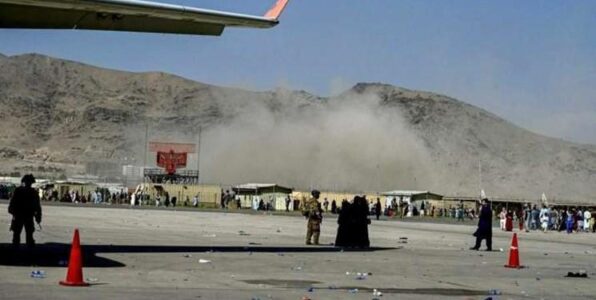
Thirteen US troops killed in the Islamic State terrorist attack on Kabul airport
The attacks from ISIS’s affiliate in Afghanistan were the deadliest US casualty event there since 2011, and they come as the US is just days away from a complete withdrawal from a country now controlled by the Taliban, POLITICO reported.
An ISIS militant wearing a suicide vest was responsible for the first bombing, two US officials and a person familiar with the matter told POLITICO, detonating around 5 pm local time just outside Abbey Gate. ISIS gunmen then opened fire on the crowd. Three sources said US troops returned fire soon after.
NATO troops were ordered to leave the airport gates immediately due to the threat of additional attacks, two people said.
Videos from the scene viewed by POLITICO showed dozens of bodies strewn across a sewage canal and the surrounding banks outside Kabul’s main airport, which President Joe Biden has warned was vulnerable to terror attacks in recent days.
In remarks at the White House later Thursday, Biden said he has ordered his top military officials to attack the terror group’s assets.
“We will respond with precision at our time at a place that we choose and the moment of our choosing,” Biden said, adding, “Here’s what you need to know: These ISIS terrorists will not win.”
The news comes just hours after defense officials began warning about an increased terrorist threat from the Islamic State’s branch in Afghanistan, known as ISIS-K. Defense officials briefed lawmakers on Tuesday about the new threat targeting airport gates and military and commercial aircraft evacuating people from Kabul, POLITICO first reported.
The explosion occurred at Abbey Gate, where US personnel until recently welcomed American citizens to board evacuation flights, and the Baron Hotel, roughly 300 meters from the site of the first detonation, Pentagon Spokesperson Kirby confirmed earlier Thursday. British troops had been using the hotel as a base for evacuating UK personnel.
“We try to push out the boundary even further so we don’t get large crowds massing at the gate,” Gen. Frank McKenzie, commander of US Central Command, told reporters.
“Clearly at Abbey Gate today we had a larger crowd there than we would like. Which goes to show you the system is not perfect,” McKenzie added.
In the meantime, the evacuation flights out of the airport are still running, a defense official told POLITICO.
While the US controls Hamid Karzai International Airport, the Biden administration has been coordinating with the Taliban on security measures outside the airport’s perimeter — a strategy that has proven complicated as Taliban fighters have reportedly been trying to prevent Afghans from fleeing the country.
The Taliban has also not stood up effective counterterrorism measures to identify and prevent threats from groups like ISIS-K, which are sworn enemies of the Taliban.
Secretary of State Antony Blinken called the attacks a “devastating reminder of the dangerous conditions in which our servicemembers and diplomats are operating”, in a statement issued later Thursday.
Rep. Michael Waltz (R-Fla.), who served in Afghanistan, told reporters that lawmakers were briefed on the ISIS-K threat during a classified session on Wednesday.
“So it was a credible and real threat,” he said.
House Minority Leader Kevin McCarthy (R-Calif.) called on Speaker Nancy Pelosi to bring the chamber back into session for briefings and possible legislative action.
On Wednesday evening local time in Washington, the US Embassy in Kabul issued an alert warning Americans to avoid the area “[b]ecause of security threats outside the gates of Kabul airport”.
Less than an hour before confirming the explosion, Kirby said the evacuation was continuing and that the US was committed to relocating “as many people as we can until the end of the mission”.
As of early Thursday morning, the White House said the total number of people evacuated from Kabul since the operation began on August 14 was 95,700, including 13,400 in the last 24 hours.
Biden has drawn bipartisan criticism for sticking to an August 31 deadline to withdraw all US troops from the country, with lawmakers and top officials warning that Americans and vulnerable Afghans would be left behind if the mission ended prematurely.
Later Thursday, Blinken said “more than 100,000 people have been safely evacuated from Kabul.”
Before the Taliban takeover, Afghan security forces had long formed a so-called ring of steel around the capital city, with multiple checkpoints operating along main roads and a US-led intelligence system tracking extremists. There have been a series of spectacular Taliban and ISIS attacks in Kabul over the years, but that old system has evaporated since the city’s fall to the Taliban, replaced by chaos and uncertainty, opening the city to attack.
Biden this week warned that ISIS wanted to strike the airport. US officials familiar with the intelligence detailed some of its specifics to POLITICO, such as ISIS’s plans to detonate a vehicle-borne improvised explosive device and launch shoulder-fired rockets.
ISIS has moved fighters and materials for the bombs from Nangarhar and Kunar provinces to areas around the airport, a US official said.
On Thursday morning, that US official added that an IED attack to breach the outer perimeter wall of the airport might come within six hours. Afterward, ISIS fighters would shoot into the crowd with machine guns and rocket-propelled grenades “in hopes of reaching processing centers” at the airport, the official said.
In the last day, the Taliban Spokesperson, Zabihullah Mujahid, had denied that an airport attack had been imminent, telling The Associated Press about the warnings, “It’s not correct.”
The attack ranks as one of the deadliest days in Afghanistan for US forces, coming behind two helicopter shootdowns.
The largest loss of life came in 2011 when a helicopter carrying 30 Americans was shot down, killing 17 Navy SEALs, five sailors, five soldiers and three airmen.
The second deadliest day came in 2005 during Operation Red Wings, when another helicopter was shot down killing eight SEALs and eight Army special operations soldiers.
Source: Farsnews





